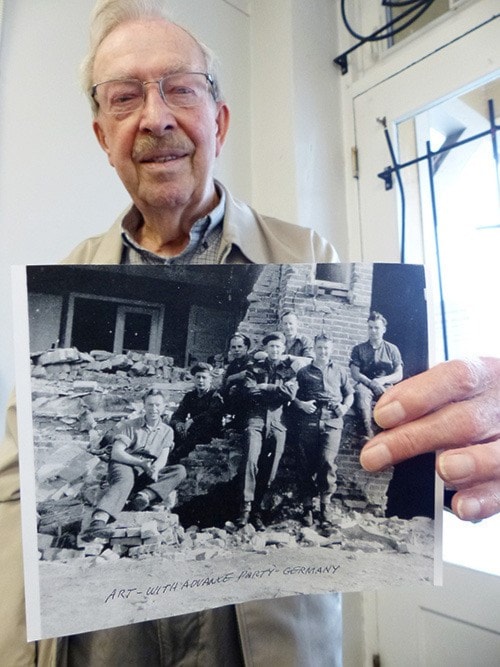Art Heming spent five years in the army during the Second World War.
He was born in Moose Jaw, Sask., to a family of seven boys – four served overseas.
The youngest was shot down over the French/German border.
“I never did see him anymore,” says Heming, 94, pausing at a memory that still stings, bringing a rush of emotions to the surface all these years later.
They’d been close; sleeping in the same bed as kids.
Heming enlisted in 1941 at the age of 21, and served with the Royal Canadian Army Service Corps, the administrative and transport corps of the army.
His first posting was Victoria, and he went overseas in 1943, first to England, then Europe.
“We were on the beaches a month after D-Day,” he says, landing at Normandy just behind the initial invasion of June 1944, following the troops through France and Belgium.
“I was in charge of vehicles, dispatching them and that sort of thing.”
In Normandy, there was bombing every night. Daytime, too, because Germans were still flying squads over the Allies in France. He recalls the time some shrapnel whistled past his ear. It was so close, he could feel its heat.
They slept in slip trenches they dug themselves. “There was dirt, dust and worms.”
They slept in their uniforms and when they got to shower, which was rarely, it was with cold water.
Heming had a camera, and today has a stack of photos he took during the war, including a  picture of the Bailey bridge they constructed at Nijmegen, in the Netherlands.
picture of the Bailey bridge they constructed at Nijmegen, in the Netherlands.
Others show Heming and other smiling young men relaxing beside rubble, or taking in a show performed for the troops, the stage a platform between two army trucks.
“I had a lot of buddies who were killed in the war,” he muses as he flips through the stack.
“It was all censored,” he says. “I had to be careful.”
His pictures show German villages that were utterly destroyed, and scenes of everyday life in Holland, where civilians had no choice but to carry on.
Heming points out a photo of a young Dutch girl who had a toothache. He had a full bottle of Aspirin and handed it to the girl’s mother, who put a tablet directly on the afflicted tooth.
A street in Amsterdam shows a horse harnessed to an automobile – there was no gasoline to fill the tank.
Letters home were also censored.
They wrote on cards that were a few inches wide, smaller than postcards.
The messages were photographed and the film flown home to Canada, where the messages were developed before they could be sent to their destinations.
Hemming sent dozens home – one a week. A commercial sign painter at Eton’s in Moose Jaw before the war, Heming drew detailed illustrations showing his folks back home what he was up to.
“I had to watch what I was sketching,” he said.
He kept a diary, too, but nearly lost it forever when he was ordered to throw it out.
He ripped the pages in half and tossed them in the bin, carefully retrieving the precious fragments when the superior’s back was turned.
He was able to smuggle the pages back home, and reassemble his war diary using Scotch tape.
A sample: “Jul 44. After travelling all night, passing the straits of Dover with no enemy action, we anchored off the French coast at approx 2000 hours the following evening, after passing a very quiet day. There was nothing exceptional to report except that on [illegible] 231 28 bottles of liquor vanished from the offrs mess lorry.”
When the war ended, he waited months for a transport ship home. He didn’t get home until February, 1945.
“They sent hockey equipment over to us. Can you imagine?” A game in Amsterdam stands out. He was skating off the rink as new teams were taking the ice, when he recognized a familiar face.
“It was my brother, right there on the ice,” he says. The reunion briefly held things up. “We hadn’t seen each other in over a year and a half.”
He married his wife, Fay, in 1948 and they have three grown children. The Hemings moved to Cloverdale aft er living in North Surrey for 25 years, and in North Vancouver for 35 years.
er living in North Surrey for 25 years, and in North Vancouver for 35 years.
“Remembrance Day,” he says, “is for those who have served and who have given their life.”
On Nov. 11, he will be thinking of his brother, who lost his life in service so long ago.
“These are the people we should remember.”
Follow the Cloverdale Reporter on  Twitter and
Twitter and ![]() Facebook. View our print edition online.
Facebook. View our print edition online.
